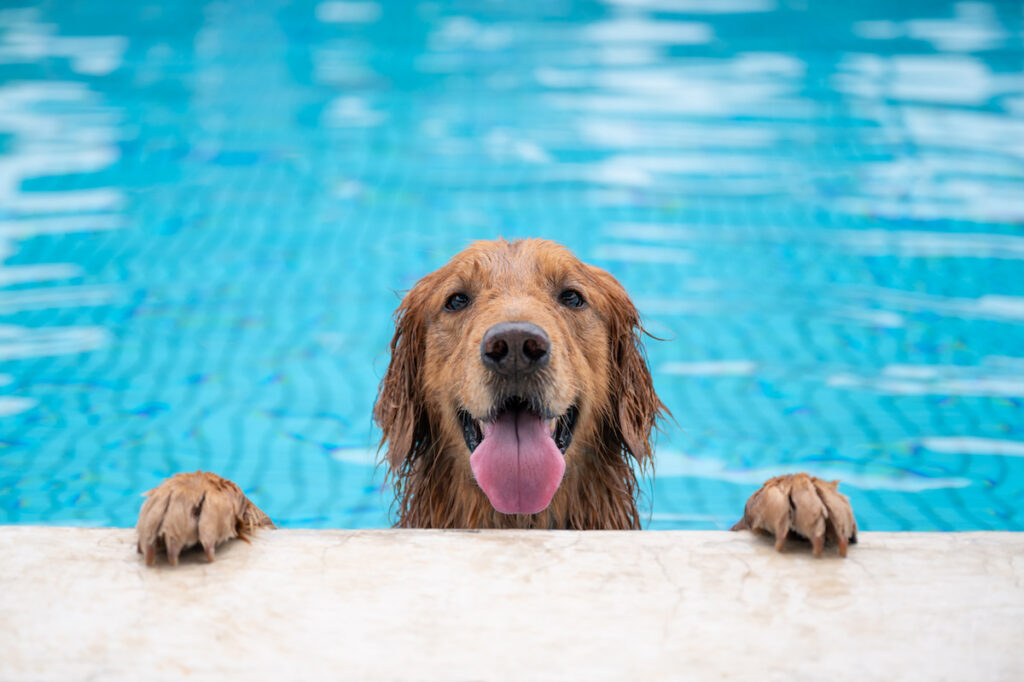For many of us, our pets are cherished members of the family, and we want to ensure their safety and well-being at all times. If you have a swimming pool, you’ll need to take extra precautions to protect your furry friends. While pools can be a source of fun and relaxation, they can also pose risks to pets. In this blog, we’ll explore important pool safety tips for pets to help you create a safe and enjoyable environment for your four-legged companions.
1. Supervision is Key
One of the most critical pool safety tips for pets is to never leave them unattended near the pool. Just as you would never leave a young child unsupervised around water, the same rule applies to pets. Always keep a watchful eye on your furry friend when they are in or near the pool.
It’s essential to stay alert, as pets can quickly get into trouble in the water, even if they are experienced swimmers. Avoid distractions like smartphones or conversations when you are responsible for supervising your pet around the pool.
2. Teach Your Pet to Swim
While some dogs are natural swimmers, others may not be as comfortable in the water. If you have a new pet or one that hasn’t been exposed to swimming, consider enrolling them in swimming lessons. Many pet training facilities offer swim classes designed to help dogs become confident swimmers.
During the training process, stay patient and supportive, as some pets may initially resist the water. Positive reinforcement and gentle encouragement can go a long way in helping your pet feel at ease in the pool.
3. Provide Easy Access
Ensure that your pet can easily enter and exit the pool. Pet-friendly pool ramps or steps can be a valuable addition to your pool area. These ramps provide a gradual incline that allows pets to enter and exit the water safely.
Avoid letting your pet jump or dive into the pool, as this can result in injury, especially if they misjudge the depth. Gradual entry and exit are safer options.
4. Use Pet Life Jackets
If your pet spends a lot of time around the pool or if you have a large or deep pool, consider investing in a pet life jacket. These specially designed vests can help your pet stay afloat and swim more efficiently. Life jackets are particularly beneficial for older pets or those with limited swimming abilities.
Ensure that the life jacket fits your pet properly and allows for comfortable movement. Test it in a controlled environment before using it in the pool to ensure your pet is comfortable with the vest.
5. Create a Secure Pool Barrier
To prevent unsupervised access to the pool area, install a secure pool barrier or fence that your pet cannot easily breach. Make sure the fence is tall enough and has no gaps or openings that your pet can slip through.
Pool covers can also be a helpful safety measure. They not only prevent pets from accidentally falling into the pool but also keep leaves and debris out. However, it’s essential to choose a cover designed for pet safety, as some standard pool covers may not support the weight of a pet.
6. Rinse Your Pet After Swimming
Chlorine and other pool chemicals can irritate your pet’s skin and eyes. After your pet has been in the pool, rinse them off with fresh water. Pay special attention to their ears to prevent water from getting trapped, which can lead to ear infections.
Dry your pet thoroughly to avoid skin issues, especially if they have a thick coat. Regular grooming can also help maintain your pet’s skin and coat health.
7. Be Cautious of Chemicals
Pool chemicals, such as chlorine, can be harmful if ingested. Ensure that your pet does not drink pool water, as it can lead to digestive issues. Additionally, store pool chemicals securely and out of your pet’s reach to prevent accidental ingestion.
If you notice any signs of discomfort or illness in your pet after they’ve been in the pool, contact your veterinarian promptly.
8.Know Pet CPR and First Aid
In case of an emergency, it’s essential to be prepared. Learn pet CPR and first aid techniques to provide immediate assistance if your pet experiences an accident or medical issue in or near the pool. Knowledge of these skills can be invaluable in a critical situation.
Conclusion
Pool safety Riverside for pets is a crucial consideration for any pet owner with a swimming pool. By following these pool safety tips, you can create a secure environment for your furry companions to enjoy the water safely. Remember that supervision, training, and appropriate safety measures are key to ensuring that your pets have a positive and safe experience around the pool. Your pet’s safety should always be a top priority, just like any other member of your family.
Riverside County Pools https://www.riversidecountypools.com/
